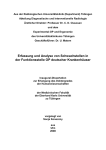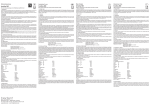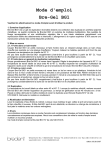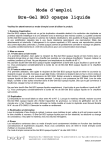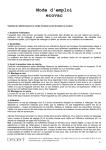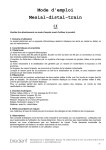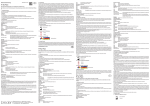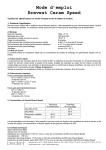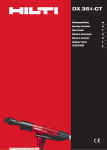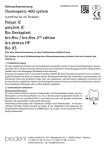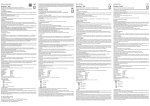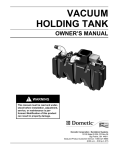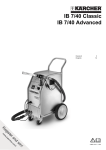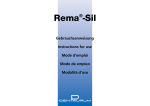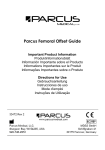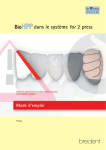Download Thermopress 400 Muffelsystem A3 2011.indd
Transcript
Gebrauchsanweisung Muffel-System thermopress 400 D Bitte diese Gebrauchsanweisung vor dem Produkteinsatz ausführlich lesen! Für Schäden, die durch Nichtbeachtung dieser Gebrauchsanweisung entstehen, lehnt der Hersteller jede Haftung ab. 1. Produktbeschreibung Das thermopress 400 Muffel-System (REF 110 0040 4) ist eine Übertragungshilfe aus rostfreiem Stahl, welche aus insgesamt 5 Bestandteilen besteht, um Einbettmassenmuffeln in thermopress 400 Spritzgussgeräten einsetzen und verarbeiten zu können. Dadurch kann der Anwender Wachsmodellationen nach zahntechnisch bekannten Verfahren modellieren, anstiften und einbetten. In dem Lieferumfang ist zusätzlich noch ein Umbausatz (Druckplatte mit Gewindestange) beigelegt. Dadurch ist dem Anwender möglich, auch bei älteren thermopress 400 Geräten das Muffelsystem verarbeiten zu können. Im Lieferumfang sind folgende Systemkomponenten enthalten: - thermopress 400 Metallrahmen (REF 360 0128 7) - thermopress 400 Bodenplatte (REF 360 0128 6) - thermopress 400 Sockelformer (REF 360 0128 5) - thermopress 400 Silikonmanschette mit O-Ring (REF 360 0128 0) - thermopress 400 Umbausatz für ältere Geräte (REF 360 0128 8) 2. Indikationen/Einsatzbereich Das thermopress 400 Muffel-System dient der Verarbeitung der thermoplastischen Werkstoffe Bio XS und bre.dentan HP. Durch die individuelle Expansionssteuerung der zu verwendeten Einbettmasse (Brevest Rapid 1) ist es möglich, mit den biokompatiblen Kunststoffen (Bio XS und bre.dentan HP) des thermopress-Systems, festsitzenden Zahnersatz (Kronen und Brücken) schnell und einfach herzustellen. 3. Kontraindikationen Das thermopress 400 Muffel-System ist nicht für die Verarbeitung anderer thermoplastischer Werkstoffe, wie z.B. bre. crystal HP, Bio Dentaplast, bre.flex, bre.flex 2nd edition geeignet. Auch für die Verarbeitung von thermoplastischen Mitbewerberwerkstoffen kann die Fa. bredent keine Verarbeitungsangaben geben. Die Verwendung des Muffel-Systems in anderen Kunststoffspritzgussgeräten beruht auf eigene Gefahr. 4. Gefahren- und Sicherheitshinweise Achtung: Vor dem Spritzvorgang muss die Muffel auf 150° C für 45 Minuten lang vorgewärmt werden. Dadurch besteht Verbrennungsgefahr beim Übersetzen der Muffel vom Vorwärmofen in das thermopress 400 Gerät. Bitte dafür nur geeignete Schutzhandschuhe oder eine Muffelzange verwenden. Bitte beachten Sie auch die Sicherheitshinweise bei der Verarbeitung von phosphatgebundenen Einbettmassen (siehe Gebrauchsanleitung von Brevest Rapid 1). 5. Lagerungs- und Haltbarkeitshinweise Keine besonderen Hinweise zu beachten! 6. Verarbeitung/Anwendung 6.1 Modellation Die Wachsmodellation wird wie gewohnt modelliert. Dabei darf eine Mindestwandstärke von 0,5 mm nicht unterschritten werden. Voraussetzung von Seiten des Zahnarztes ist eine Hohlkehlpräparation (siehe Abb. 1). Abb. 1: Hohlkehlpräparation 6.2 Anstiften Erforderliche Hilfsteile: a) Sockelformer, Silikonmanschette b) Wachsprofile auf Rollen, 2,0 mm (REF 430 0116 0) c) Wachsprofile auf Rollen, 5,0 mm (REF 430 0118 5) d) thermopress Spritzkanalwachs 10 mm (REF 430 0741 0) Abb. 7: Umbetten mit ExpandoRock Ist das zu verwendende Material aufgeschmolzen, angezeigt durch ein akustisches Signal, wird die Metallmuffel aus dem Vorwärmofen in das thermopress 400 Gerät platziert und zuerst die vordere Spannschraube ohne Klemmwirkung und anschließend die seitliche Spannschraube handfest angezogen. Danach werden beide Spannschrauben fester angezogen. Der Spritzvorgang kann nun ausgelöst werden. Wichtig: Bei älteren Geräten besitzt die vordere Spannvorrichtung einen dickeren Druckteller (siehe Abb. 8). Dieser Druckteller muss mit dem im Muffel-Set beiliegenden Umbausatz ausgetauscht werden. Bei neuen Geräten ist diese Maßnahme nicht erforderlich, da diese bereits einen schmalen Druckteller besitzen. Die Bedienung des Gerätes erfolgt gemäß der Gebrauchsanweisung. Abb. 8: Austausch des Drucktellers (Umbausatz) 6.5 Ausbettvorgang Nachdem der Pressstempel des thermopress 400 Gerätes in seine Ausgangsposition wieder zurückgefahren ist, können die beiden Spannschrauben gelöst und der seitliche Spannbügel muss hochgeklappt werden, da ansonsten beim Auswerfvorgang der Kartusche das Gerät beschädigt werden kann. Nach dem Kartuschenauswurf kann die Muffel aus dem thermopress 400 Gerät entnommen werden. Mit einem Kunststoffhammer wird an der Unterseite der Metallrahmen leicht auf die Bodenplatte geschlagen und die gesamte EBM-Muffel mit Expando-Rock-Ummantelung aus dem Metallrahmen herausgeholt. Unter Verwendung eines pneumatischen Ausbettmeißels oder mit leichten Hammerschlägen wird das Spritzobjekt vorsichtig ausgebettet. Das gesamte Spritzobjekt wird mit 125 µ Al2O3 und 3 bar Strahldruck von EBM-Resten befreit und kann anschließend mit rotierenden Instrumenten aufgepasst werden. Die Spritzkanäle können mit einer Diamantscheibe entfernt werden. The resin injection channel (sprue - 10 mm) is placed in the opening of the base former and cut off to obtain a length of 10 mm. A wax channel (sprue - 2 mm) is attached to each bridge unit (vertical to the occlusion surface). This 2 mm wax sprue is affixed directly to the incisal edge of anterior teeth. A 5 mm injection bar is fastened horizontally to each 2 mm wax sprue at a distance of 3 mm. One end is attached to the main sprue and the other end is bent upwards to serve as a pressure compensation sprue. A hot wax knife is used to reduce the diameter of this pressure compensation sprue (half of its original size) (see fig. 2). The excess material can escape during the injection process and the object will not be damaged by excessive pressure. The bottom plate features a recess to take up the excess material. Observe instructions for use Fig. 1: Chamfer preparation Fig. 2: Attaching the injection sprues Fig. 3: Distance to the silicone sleeve: 5 mm Once the wax model has been attached to the base former, Isosil is sprayed onto the inner side of the silicone sleeve and the base former. Then the silicone sleeve is placed on the base former. Make sure to keep a minimum distance of 5 mm between the wax model and the silicone sleeve (see fig. 3). 160 g of Brevest Rapid investment material need to be mixed with a 82 ° concentration of Brevest R in a vacuum mixing unit for 60 sec and the formation of bubbles must be avoided. Then the investment material is filled into the muffle (use a dental vibrator). After a hardening time of 20 min., the muffle (without the silicone sleeve and the base former) is preheated in the preheating furnace for 60 min. at 900°C and the wax is eliminated. Then the muffle needs to cool down to room temperature. Afterwards the base plate is placed into the metal frame and this way the bottom is sealed tightly (see fig. 4). 7. Technische Daten Gewicht (Metallrahmen) = 2 kg Gewicht Muffel-System insgesamt = 3 kg Maße des Metallrahmens B x H x T in mm= 67 x 127 x 84 9. Sonstige Hinweise Die Angaben dieser Gebrauchsanweisung werden stets den aktuellsten Ergebnissen und Erfahrungen angepasst. Wir empfehlen daher, vor Benutzung, die Gebrauchsanweisung zu lesen. Diese unverbindlichen Anwenderempfehlungen beruhen auf eigenen Erfahrungen. Der Benutzer ist für die Anwendung des Produktes selbst verantwortlich. Für fehlerhafte Ergebnisse wird nicht gehaftet, da bredent keinen Einfluss auf die Weiterverarbeitung hat. Eventuell dennoch auftretende Schadenersatzansprüche beziehen sich ausschließlich auf den Warenwert unserer Produkte. Das Produkt darf nur von Zahnärzten, Zahntechnikern und entsprechend geschultem Fachpersonal verwendet werden. Für die Verarbeitung sind nur Originalwerkzeuge und -teile zu verwenden. Nachdem die Wachsmodellation auf den Sockelformer angestiftet wurde, wird die Innenseite der Silikonmanschette und der Sockelformer mit Isosil eingesprüht. Dann wird die Silikonmanschette auf den Sockelformer aufgesetzt. Dabei darf ein Mindestabstand von 5 mm zwischen Wachsmodellation und Silikonmanschette nicht unterschritten werden (siehe Abb. 3). Insgesamt müssen 160 g Einbettmasse Brevest Rapid 1 mit einer 82 %-igen Konzentration Brevest R in einem Vakuumanmischgerät 60 Sek. lang blasenfrei angemischt werden. Anschließend wird die Einbettmasse mit Hilfe eines Dentalvibrators in die Muffel überführt. Nach einer 20 Min. Aushärtezeit wird die Muffel ohne die Silikonmanschette und den Sockelformer im Vorwärmofen bei 900° C für 60 Min. vorgeheizt und das Wachs ausgetrieben. Anschließend muss die Muffel auf Raumtemperatur abkühlen. Nun wird die Bodenplatte in den Metallrahmen gelegt und somit die Unterseite dicht verschlossen (siehe Abb. 4). Abb. 4: Metallrahmen mit eingesetzter Bodenplatte Die auf Raumtemperatur abgekühlte EBM-Muffel wird in diesem Metallrahmen mittig auf der Bodenplatte ausgerichtet (siehe Abb. 5). Der Sockelformer dient auch als Druckplatte und wird mit Hilfe des Führungsstifts auf die EBM-Muffel aufgesetzt. Abb. 5: Platzierung der Einbettmassen-Muffel in Metallrahmen Abb. 4: Metal frame with inserted base plate Instructions for use thermopress 400 muffle system The scope of delivery includes the following components: - thermopress 400 metal frame (REF 360 0128 7) - thermopress 400 base plate (REF 360 0128 6) - thermopress 400 base former (REF 360 0128 5) - thermopress 400 silicone sleeve with O-ring (REF 360 0128 0) - thermopress 400 conversion kit for older units (REF 360 0128 8) 2. Indication range The thermopress 400 muffle system is used for processing the thermoplastic materials Bio XS and bre.dentan HP. Thanks to individual expansion control of the investment material (Brevest Rapid 1) fast and simple fabrication of fixed dental restorations (crowns and bridges) with the biocompatible resins (Bio XS and bre.dentan HP) of the thermopress system is enabled. 3. Contraindications The thermopress 400 muffle system is not suitable for processing other thermoplastic materials, such as bre.crystal HP, Bio Dentaplast, bre.flex and bre.flex 2nd edition. bredent is not able to provide any processing information on processing other thermoplastic materials from competitors either. Usage of the muffle system in other resin injection systems is at the user‘s own risk. 4. Safety recommendations and hazard warning Note: The muffle needs to be preheated to 150°C for 45 minutes before the injection process. As a result, there is a risk of getting burned when taking the muffle out of the preheating furnace and placing it into the thermopress 400 unit. Please use only suitable protective gloves or muffle (furnace) tongs. Please observe also the relevant safety recommendations when processing phosphate-bonded investment materials (see instructions for use for Brevest Rapid 1). Système de moufle thermopress 400 Veuillez lire attentivement ce mode d’emploi avant d’utiliser ce produit. Le fabricant décline toute responsabilité pour tout dommage qui résulterait de la non observation de ce mode d’emploi. 1. Description du produit Le système de moufles thermopress 400 (REF 110 0040 4) est un soutien de transfert en acier inoxydable comprenant 5 pièces au total et permettant l’utilisation et la mise en œuvre de moufles à revêtement dans les appareils thermopress 400. Ainsi l’utilisateur peut réaliser des maquettes en cire selon les procédés connus en prothèse, les mettre en place avec les tiges de coulée et les mettre en revêtement. La livraison comprend également un kit de modification (rondelle de mise sous pression avec tige filetée). Ceci permet à l’utilisateur d’utiliser le système de moufles avec les anciens appareils thermopress 400. La fourniture comprend les composants suivants du système: - Cadre en métal thermopress 400 (REF 360 0128 7) - Plaque de base thermopress 400 (REF 360 0128 6) - Moule pour socle thermopress 400 (REF 360 0128 5) - Manchette en silicone avec bague en O thermopress 400 (REF 360 0128 0) - Kit de modification thermopress 400 pour les anciens appareils (REF 360 0128 8) Fig. 5: Placement of the investment material muffle in the metal frame Important: The base former features an arrow marker. This marker must be aligned with the groove of the metal frame (see fig. 6) to ensure the correct distance of the injection sprue to the opening of the aluminium cartridge; the liquid material can be properly injected into the muffle. Fig. 6: Aligning the base plate towards the metal frame The empty space between the investment material muffle and the metal frame is filled with Expando-Rock (26 ml concentrate : 100 g powder) up to the upper edge of the metal frame (see fig. 7). Please make sure to cover the injection opening for a short time. 6.4 Injection process After filling the investment material muffle in the metal frame, the plaster needs to harden approx. 30 min. Then the entire muffle is preheated at 150°C for 45 min. At the same time, the program of the injection moulding system thermopress 400 for processing Fig. 7: Filling with Expando-Rock Bio XS or bre.dentan HP can already be selected and started. The heating process starts. Once the material to be used has melted, which is indicated by an acoustic signal, the metal muffle is removed from the furnace and placed in the thermopress 400 unit; first the front clamping screw (without clamping effect) and then the lateral clamping screw are hand-tightened. Then both clamping screws are tightened further. Afterwards the injection process can be started. 3. Contre-indications Le système de moufles thermopress 400 n’est pas approprié à la mise en œuvre d’autres matériaux thermoplastiques comme par ex. le bre.crystal HP, Bio Dentaplast, bre.flex, bre.flex 2ème édition. Egalement pour la mise en œuvre de matériaux thermoplastiques de nos concurrents, la société bredent ne peut pas donner d’indications. L’utilisation du système de moufles dans d’autres appareils d’injection se fait sous votre responsabilité. 4. Dangers et consignes de sécurité Mise en garde: Avant le processus d’injection il faut préchauffer le moufle à 150°C durant 45 minutes. De ce fait on risque de se brûler en transférant le moufle du four de préchauffage à l’appareil thermopress 400. A cet effet, veuillez utiliser des gants de protection appropriés ou une pince à moufles. Veuillez également observer les recommandations de sécurité pour les matériaux de revêtement liés aux phosphates (voir mode d’emploi de Brevest Rapid 1). Important: The front clamping device of older units features a thicker pressure plate (see fig. 8).This pressure plate needs to be exchanged using the conversion kit enclosed to the muffle set. New units already have a thin pressure plate which does not need to be exchanged. The unit is operated in accordance with the operating instructions. 6.5 Devesting Once the press plunger of the thermopress 400 unit has returned to the initial position, Fig. 8: Exchanging the pressure both clamping screws can be loosened and the lateral bracket needs to be lifted up plate (conversion kit) to avoid damaging the unit when ejecting the cartridge. After ejecting the cartridge, the muffle can be removed from the thermopress 400 unit. Use a plastic hammer to tap lightly onto the base plate at the bottom of the metal frame to remove the entire investment material muffle with the surrounding Expando-Rock material from the metal frame. The injected object is carefully removed using a pneumatic deflasking chisel or light hammer taps. Investment material residues are removed from the injected object using 125 µm Al2O3 and a pressure of 3 bar. The injection sprues can be removed with a diamond disc. Fig. 1: Préparation en congé 6.2 Fixation des canaux d’injection Pièces auxiliaires nécessaires: a) Moule pour socle, manchon en silicone b) Profilés en cire sur rouleaux, 2,0 mm (REF 430 0116 0) c) Profilés en cire sur rouleaux, 5,0 mm (REF 430 0118 5) d) Cire pour canaux d’injection thermopress 10 mm (REF 430 0741 0) Important: Le moule pour socle est muni d’un marquage à flèche. Il faut que cette marque soit alignée sur l’encoche dans le cadre métallique (cf. Fig. 6). Ce n’est qu’ainsi que l’intervalle du canal de coulée coincide avec l’ouverture de la cartouche en aluminium ; le matériau liquide peut ainsi être injecté dans le moufle sans que le courant d’injection ne soit gêné. Fig. 5: Mise en place du moufle à revêtement dans le cadre en métal. Fig. 6: Alignement de la plaque de base avec le cadre métallique 6.4 Processus d’injection Après la mise en revêtement secondaire du moufle à revêtement, laisser le plâtre durcir env. 30 min. Ensuite on procède au préchauffage du moufle entier à 150°C durant 45 min. Simultanément on peut déjà présélectionner et mettre en marche le programme pour la mise en œuvre de Bio XS ou de bre.dentan HP sur l’appareil d’injection thermopress 400. Le processus de chauffage se met en marche. Abb. 7: Mise en revêtement secondaire avec Thixo-Rock Un signal acoustique retentit dès que le matériau à utiliser est fondu, transférer alors la moufle en métal du four de préchauffage à l’appareil thermopress 400 et serrer tout d’abord la vis de serrage à l’avant sans effet de blocage et ensuite la vis de serrage latérale selon la force manuelle. Puis serrer les deux vis de serrage plus fort. Maintenant on peut déclencher le processus d’injection. Important: Le dispositif de serrage à l’avant des appareils plus anciens est muni d’une rondelle à pression plus épaisse (cf. Fig. 8). Remplacer cette rondelle à pression en se servant du kit de modification joint aux moufles. Pour les appareils neufs cette mesure n’est pas nécessaire car ils sont déjà munis d’une rondelle à pression plus mince. Pour une bonne utilisation de l’appareil, veuillez respecter le mode d’emploi. Fig. 8: Remplacement de la rondelle à pression (kit de modification). 6.5 Processus de démouflage Quand le fouloir de l’appareil thermopress 400 est revenu à sa position de départ, on peut desserrer les deux vis de serrage et relever la bride de tension latérale pour empêcher que l’appareil ne soit endommagé durant le processus d’éjection de la cartouche. Après l’éjection de la cartouche on peut retirer le moufle de l’appareil thermopress 400. Frapper légèrement avec un marteau en plastique sur la partie inférieure du cadre métallique et sortir tout le moufle EBM avec son enveloppe d’Expando-Rock du cadre métallique. En utilisant un burin de démouflage pneumatique ou à l’aide de légers coups de marteau procéder prudemment au démouflage de l’objet injecté. Sabler l’objet injecté avec du Al2O3 de 125 µm à 3 bars de pression pour le libérer des résidus de EBM et l’adapter ensuite avec des instruments rotatifs. Enlever les canaux d’injection avec un disque diamanté. 7. Caractéristiques techniques Poids (cadre métallique) = 2 kg Poids du système de moufle complet = 3 kg Dimensions du cadre métallique l x H x P en mm = 67 x 127 x 84 Placer le canal d’injection pour résine dans l’ouverture du moule pour socle et le couper vers le haut sur une longueur d’env. 5 mm. Doter chaque élément de bridge à la verticale de la surface d’occlusion d’un canal en cire de 2 mm d’épaisseur. Pour la zone incisive on fixe ce canal directement sur l’arête de la dent. En observant un Fig. 2: Fixation des canaux intervalle de 3 mm, on fixe horizontalement un râteau d’injection de 5 mm à chaque d’injection canal en cire de 2 mm d’épaisseur. L’un des bouts est ramené au canal d’alimentation principal et l’autre bout recourbé vers le haut servira de canal de compensation de pression. A l’aide d’un couteau à cire réduire de 50% le diamètre de ce canal de compensation de pression (cf. Fig. 2). Ainsi le matériau en superflu peut s’échapper pendant le processus d’injection sans endommager l’ouvrage du fait d’une pression trop élevée. La plaque de base est munie d’une cavité pour recueillir le matériau superflu. Important: Veiller à un intervalle suffisant (au moins 5 mm) entre la maquette de cire et le canal de compensation de pression de la paroi intérieure de la manchette en silicone (cf. Fig. 3). 6.3 Préparation du moufle Auxiliaires et appareils nécessaires: a) Moule pour socle, cadre en métal, plaque de base b) Manchette en silicone c) Isosil (REF 520 IS12 5) d) Brevest Rapid 1 (REF 570 160R 4) e) Appareil de malaxage sous vide ecovac (REF 140 0093 0) f) Vibrateur dentaire g) Four de préchauffage h) Expando-Rock (REF 570 0ERS 5) Le moufle EBM refroidi à la température ambiante est placé au milieu de la plaque de base (cf. Fig. 5). Le moule pour socle sert aussi de plaque de pression et à l’aide de la tige de guidage on l’aligne sur le moufle EBM. Remplir l’espace libre entre le moufle EBM et le cadre métallique d’ExpandoRock (26 ml de concentré sur 100 g de poudre) jusqu’au bord supérieur du cadre métallique (cf. Fig. 7). Veillez à recouvrir l’ouverture d’injection pour un court instant. 2. Indications / Domaine d’application Le système de moufles thermopress 400 sert à la mise en œuvre des matériaux thermoplastiques Bio XS et bre.dentan HP. Grâce au contrôle de l’expansion au cas par cas du matériau de revêtement à utiliser (Brevest Rapid 1), il est possible de réaliser de façon rapide et simple des restaurations conjointes (couronnes et bridges) à l’aide des résines biocompatibles (Bio XS und bre.dentan HP) du système thermopress. 6.1 Sculpture Sculpter la maquette de cire comme d’habitude en veillant à avoir une épaisseur de paroi minimum de 0,5 mm. Une condition nécessaire est que le chirurgien-dentiste ait réalisé une préparation en congé (cf. Fig. 1). Fig. 4: Cadre en métal avec plaque de base mise en place. F 6. Mise en œuvre / Utilisation GB 1. Product description The thermopress 400 muffle system (REF 110 0040 4) is a transfer tool made of stainless steel and consists of 5 components. It is used to be able to insert investment material muffles (rings) into thermopress 400 injection moulding units and to process them. The user is enabled to model, sprue and invest wax models in accordance with familiar dental procedures. The scope of delivery includes an additional conversion kit (pressure plate with threaded bar), which enables the user to process the muffle system with older thermopress 400 units. Mode d’emploi 5. Consignes de stockage et date de péremption Il n’y a rien de particulier à observer. Bei Fragen zum Handling melden Sie sich direkt unter der Rufnummer 0 73 09 / 8 72-22! Before using the product, please read these instructions for use carefully! The manufacturer will not accept any liability for damage. Abb. 3: Abstand zur Silikonmanschette 5 mm The investment material muffle that has cooled down to room temperature is centered on the base plate in this metal frame (see fig. 5). The base former also serves as a pressure plate and is placed on the investment material muffle using the guide pin. 9. Additional information The information contained in these instructions for use is always updated according to the latest knowledge and experience. Therefore we recommend to read the instructions for use again before using a new package. These non-binding user recommendations are based on our own experience. The user himself is responsible for processing the product. Liability for incorrect results shall be excluded since bredent does not have any influence on further processing. Any occurring claims for damages may only be made up to the value of our products. The product may only be used by dentists, dental technicians and adequately trained dental staff. Only original tools and components may be used for processing. If you have questions concerning handling, please call +49 - 73 09 / 8 72-22! Important: Sufficient distance (at least 5 mm) between the wax model and the pressure compensation sprues towards the inner wall of the silicone sleeve must be ensured (see fig. 3). 6.3 Preparation of the muffle Parts/components/devices required: a) Base former, metal frame, base plate b) Silicone sleeve c) Isosil (REF 520 IS12 5) d) Brevest Rapid 1 (REF 570 160R 4) e) ecovac vacuum mixing unit (REF 140 0093 0) f) Dental vibrator g) Preheating furnace h) Expando-Rock (REF 570 0ERS 5) Maintenant on place la plaque de base dans le cadre métallique et ainsi la partie inférieure est fermée avec une grande étanchéité (cf. Fig. 4). 8. Symbols Gebrauchsanweisung beachten Wichtig: Bitte auf ausreichenden Abstand (min. 5 mm) zwischen Wachsmodellation und Druckausgleichskanal zur Silikon Manschetteninnenwandung achten (siehe Abb. 3). GmbH & Co.KG · Weissenhorner Str. 2 · 89250 Senden · Germany Tel. (+49) 0 73 09 / 8 72-22 · Fax (+49) 0 73 09 / 8 72-24 www.bredent.com · e-mail [email protected] Der freie Raum zwischen EBM-Muffel und Metallrahmen wird mit Expando-Rock (26 ml Konzentrat auf 100 g Pulver) bis zur Oberkante des Metallrahmens aufgefüllt (siehe Abb. 7). Bitte darauf achten, dass die Injektionsöffnung kurzfristig abgedeckt wird. 6.1 Modelling The wax model is fabricted in the usual way. A minimum wall thickness of 0.5 mm must be ensured. Chamber preparation by the dentist is required (see fig. 1). 6.2 Spruing Parts/components required: a) Base former, silicone sleeve b) Reels of wax pattern, 2.0 mm (REF 430 0116 0) c) Reels of wax pattern, 5.0 mm (REF 430 0118 5) d) thermopress acrylic sprue wax, 10 mm (REF 430 0741 0) 8. Verwendete Symbole Der 10 mm Kunststoffspritzkanal wird in der Öffnung des Sockelformers platziert und nach ca. 5 mm Länge nach oben abgeschnitten. Jedes Brückenglied wird mit einem 2 mm Wachskanal senkrecht zur Okklusionsfläche bestückt. Bei Frontzähnen wird dieser 2 mm Wachskanal direkt auf die Schneidekante fixiert. In einem Abstand von Abb. 2: Anbringen der Spritz3 mm wird ein 5 mm Spritzbalken an jeden 2 mm Wachskanal horizontal be- kanäle festigt. Das eine Ende wird auf den Hauptzuführungskanal angeschwemmt und das andere Ende nach oben gebogen, welches als Druckausgleichskanal dienen wird. Der Durchmesser dieses Druckausgleichskanals wird mit einem heißen Wachsmesser auf die Hälfte reduziert (siehe Abb. 2). Somit kann das überschüssige Material während des Injektionsprozesses entweichen und nicht das Objekt durch zu hohen Druck schädigen. Die Bodenplatte besitzt eine Vertiefung, welche das überschüssige Material aufnimmt. 6.3 Vorbereitung der Muffel Erforderliche Hilfsteile und Geräte: a) Sockelformer, Metallrahmen, Bodenplatte b) Silikonmanschette c) Isosil (REF 520 IS12 5) d) Brevest Rapid 1 (REF 570 160R 4) e) ecovac Vakuumanmischgerät (REF 140 0093 0) f) Dentalvibrator g) Vorwärmofen h) Expando-Rock (REF 570 0ERS 5) 6. Processing/Use Abb. 6: Ausrichtung der Bodenplatte zum Metallrahmen 6.4 Spritzvorgang Nach dem Umbetten der Einbettmassenmuffel im Metallrahmen muss der Gips ca. 30 Min. aushärten. Anschließend wird die gesamte Muffel bei 150° C für 45 Min. vorgewärmt. Gleichzeitig kann schon das Programm für die Verarbeitung von Bio XS oder für bre.dentan HP am Spritzgussgerät thermopress 400 ausgewählt und gestartet werden. Der Aufheizprozess beginnt. 7. Technical data Weight (metal frame) = 2 kg Total weight of muffle system = 3 kg Dimensions of the metal frame - w x h x d in mm = 67 x 127 x 84 5. Durability and storage No special recommendations need to be observed! Wichtig: Der Sockelformer besitzt eine Pfeilmarkierung. Diese Markierung muss auf die Einkerbung des Metallrahmens ausgerichtet sein (siehe Abb. 6). Nur so stimmt der Abstand des Spritzkanals mit der Öffnung der Aluminiumkartusche überein und das flüssige Material kann strömungsgerecht in die Muffel eingespritzt werden. 8. Symboles utilisés Veuillez observer le mode d’emploi. 9. Divers Ce mode d’emploi est basé sur les connaissances techniques actuelles et sur nos propres expériences remises à jour. Avant toute utilisation, nous vous recommandons de lire le mode d’emploi. Ces recommandations sans engagement de notre part sont basées sur nos propres expériences. L’utilisateur est lui-même responsable de l’utilisation du produit. Le fabricant ne saurait être tenu responsable de résultats défectueux ou non satisfaisants, bredent n’ayant aucune influence sur la mise en œuvre. Toute indemnisation éventuelle se limitera à la valeur du produit. Le produit doit uniquement être utilisé par des chirurgiens-dentistes, des prothésistes ou du personnel ayant subi une formation adéquate. Pour la mise en œuvre utiliser uniquement des instruments et pièces originales. Pour toutes questions relatives à la mise en œuvre, veuillez nous contacter directement sous le numéro de téléphone 0 73 09 / 8 72-22 ! Fig. 3: Intervalle de 5 mm vers la manchette en silicone Après avoir fixé les tiges de la maquette en cire sur le moule pour socle, on vaporise l’intérieur de la manchette en silicone et le moule pour socle avec de l’Isosil. Ensuite on place la manchette en silicone sur le moule pour socle. Ne pas aller au delà d’un intervalle minimum de 5 mm entre la maquette de cire et la manchette en silicone (cf. Fig. 3). Mélanger durant 60 sec. 160 g de matériau de revêtement Brevest Rapid 1 avec Brevest R en concentration de 82% dans un appareil de malaxage sous vide sans qu’il n’y ait de formation de bulles. Puis on transfert le matériau de revêtement dans le moufle à l’aide du vibrateur dentaire. Après une durée de durcissement de 20 min., préchauffer le moufle à 900°C durant 60 min. dans le four de préchauffage sans la manchette en silicone et le moule pour socle et éliminer la cire. Laisser ensuire le moufle refroidir pour atteindre la température ambiante. Istruzioni d‘uso Cilindro per sistema ad iniezione thermopress 400 I Leggere attentamente le istruzioni d’uso prima dell’utilizzo del prodotto! Il produttore non si assume alcuna responsabilità per danni, dovuti all’inosservanza delle presenti istruzioni d’uso. 1. Descrizione del prodotto Il cilindro per il sistema ad iniezione thermopress 400 (REF 110 0040 4) è uno strumento ausiliario in acciaio inossidabile, composto da 5 pezzi, indicato per l‘inserimento e la lavorazione dei cilindri in rivestimento nell‘apparecchio ad iniezione thermopress 400. Grazie a ciò l‘utente può eseguire la modellazione in cera, l‘imperneatura e la messa in rivestimento in base alle consuete tecniche, utilizzate in laboratorio. Nella confezione è accluso anche un set di conversione (piastra di pressione con vite filettata). In questo modo l‘utente può utilizzare il cilindro anche con apparecchi thermopress 400 più datati. Nella confezione sono contenuti i seguenti componenti: - thermopress 400 Telaio in metallo - thermopress 400 Piattaforma - thermopress 400 Base per cilindro - thermopress 400 Cilindro in silicone con O-Ring - thermopress 400 Set di conversione per apparecchi più datati (REF 360 0128 7) (REF 360 0128 6) (REF 360 0128 5) (REF 360 0128 0) (REF 360 0128 8) 2. Indicazioni/campi d‘applicazione Il cilindro thermopress 400 è indicato per la lavorazione dei materiali termoplastici Bio XS e bre.dentan HP. Grazie al controllo individuale dell’espansione della massa di rivestimento utilizzata (Brevest Rapid 1), è possibile realizzare, in modo facile e veloce, protesi fisse (ponti e corone) con le resine biocompatibili (Bio XS e bre.dentan HP) del sistema thermopress. 3. Controindicazioni Il cilindro thermopress 400 non è indicato per la lavorazione di altri materiali termoplastici, come p.es. bre.crystal HP, Bio Dentaplast, bre.flex, bre.flex 2nd edition. Anche nel caso di materiali termoplastici concorrenti, la ditta bredent non può fornire dati di lavorazione. L‘utilizzo del cilindro su altri apparecchi ad iniezione rimane a proprio rischio e pericolo. 4. Avvertenze sui pericoli e per la sicurezza Attenzione: Prima della fase d‘iniezione, il cilindro deve essere preriscaldato a 150° C per 45 minuti. Perciò durante il trasferimento del cilindro dal forno di preriscaldo all‘apparecchio thermopress 400 può verificarsi il pericolo di ustioni. A tale scopo indossare solo appositi guanti protettivi od utilizzare una pinza per cilindri. Leggere anche le avvertenze sulla sicurezza durante la lavorazione delle masse da rivestimento a legante fosfatico (vedere le istruzioni d‘uso di Brevest Rapid 1). 5. Avvertenze per la conservazione e la durata Non ci sono particolari avvertenze da osservare! 6. Lavorazione/Applicazione 6.1 Modellazione Eseguire la modellazione in cera come di consueto. Non superare uno spessore delle pareti di 0,5 mm. Premessa da parte dell‘odontoiatra è la preparazione della spalla cervicale (fig. 1). 6.2 Imperneatura Componenti necessari: a) Base per cilindro, cilindro in silicone con O-ring b) Filo in cera a rotoli, 2,0 mm (REF 430 0116 0) c) Filo in cera a rotoli, 5,0 mm (REF 430 0118 5) d) Canale d‘iniezione in cera thermopress 10 mm (REF 430 0741 0) Fig. 1: preparazione della spalla cervicale Inserire il canale d‘iniezione da 10 mm nell‘apposita apertura sulla base del cilindro e tagliare in alto a ca. 5 mm di lunghezza. Ogni elemento del ponte viene dotato di un canale in cera con un diametro da 2 mm, posizionato in senso verticale rispetto alla superficie d‘occlusione. Per gli incisivi il canale in cera da 2 mm viene fissato direttamente sui bordi incisali. Su ogni canale in cera da 2 mm viene fissata in senso oriz- Fig. 2: applicazione dei canali zontale una barra d‘iniezione da 5 mm lasciando una distanza di 3 mm. Un‘estremità d‘iniezione viene portata sul canale d‘alimentazione principale e l‘altra piegata verso l‘alto, in modo da essere utilizzata come canale di compensazione della pressione. Il diametro di questo canale di compensazione della pressione viene ridotto della metà utilizzando una spatola elettrica (vedere fig. 2). In tal modo, durante il processo d‘iniezione, il materiale in eccesso può fuoriuscire, evitando di danneggiare il manufatto a causa della pressione troppo alta. La piattaforma del cilindro è dotata di un incavo che provvede a raccogliere il materiale in eccesso. Importante: Si deve fare attenzione a lasciare una distanza sufficiente (min. 5 mm) tra la modellazione in cera, il canale di compensazione della pressione e la parete interna del cilindro in silicone (vedere fig. 3). 6.3 Preparazione del cilindro Componenti ed apparecchi necessari: a) Base per cilindro, telaio in metallo, piattaforma b) Cilindro in silicone c) Isosil (REF 520 IS12 5) d) Brevest Rapid 1 (REF 570 160R 4) e) Ecovac apparecchio per miscelazione sottovuoto (REF 140 0093 0) f) Vibratore dentale g) Forno di preriscaldo h) Expando-Rock (REF 570 0ERS 5) Fig. 3: distanza 5 mm fino alla parete del cilindro in silicone Dopo l‘imperneatura del modellato in cera sulla base per il cilindro, spruzzare l‘isolante Isosil sulla parete interna del cilindro in silicone e sulla base. Successivamente applicare il cilindro in silicone sulla base. La distanza minima tra il modellato in cera ed il cilindro in silicone non deve essere inferiore a 5 mm. (vedi fig. 3). Nell‘apparecchio per miscelazione sottovuoto devono essere miscelati in totale 160 gr di massa da rivestimento Brevest Rapid 1 e Brevest R con una concentrazione dell‘82 %, per 60 secondi, evitando la formazione di bolle. Successivamente con l‘ausilio di un vibratore dentale riempire il cilindro con la massa di rivestimento. Dopo 20 min. dalla miscelazione il cilindro viene messo nel forno di preriscaldo a 900° C per 60 min., senza il cilindro in silicone e la base, e durante il preriscaldo la cera viene sciolta ed eliminata. Al termine lasciare raffreddare il cilindro a temperatura ambiente. Folleto de instrucciones Importante: La base del cilindro è dotata di una demarcazione a forma di freccia, che deve essere allineata con l‘incisione posta sul telaio in metallo (vedere fig. 6). Solo in questo modo la distanza del canale d‘iniezione è conforme all‘apertura della cartuccia d‘alluminio ed il materiale può essere iniettato nel cilindro con un flusso corretto. Sistema de cilindro thermopress 400 E Rogamos lean detenidamente la información de producto ante de su uso. Importante: El formador de base tiene una flecha como marca. Esta marca se deberá posicionar hacia la hendidura del marco metálico (ver imagen 6). Solo así será correcto la distancia de bebedero de inyección con la apertura del cartucho de aluminio y así podrá entrar correctamente el material líquido hacia el cilindro. Por daños producidos por no tener en cuenta esta hoja de instrucción, no se hace responsable el fabricante. Fig. 6: Allineamento della base con il telaio in metallo Lo spazio libero tra il cilindro in rivestimento ed il telaio in metallo viene riempito con il gesso Expando-Rock (26 ml di concentrato su 100 gr di polvere) fino all‘angolo superiore del telaio in metallo (vedere fig. 7). Fare attenzione, che il foro d‘apertura per il processo d‘iniezione venga liberato dal gesso rapidamente. 6.4 Processo d‘iniezione Dopo aver riempito lo spazio intorno al cilindro in rivestimento con Fig. 7: Lo spazio intorno al cilindro il gesso, nel telaio in metallo, è necessario lasciare indurire il gesso per in rivestimento viene riempito con ca. 30 minuti. Successivamente tutto il cilindro viene preriscaldato a 150°C per Expando-Rock 45 minuti. Contemporaneamente è già possibile selezionare, sull‘apparecchio per iniezione thermopress 400, il programma per la lavorazione di Bio XS o di bre.dentan HP ed avviarlo. Ha inizio la fase di riscaldamento. 1. Descripción de producto El sistema de cilindro thermopress 400 (REF 110 0040 4) es una ayuda de transmisión de acero inoxidable, que consta de 5 piezas, un cilindro para revestimiento para poder usarlo en la máquina del sistema de inyección thermopress 400 y así poder trabajar con ella. Así podrá el técnico modelar como las normas dentales convencionales, colocar bebederos y revestir. En el envío de cilindro se ha adjuntado un soporte (placa de presión con Tornillo de rosca) para acoplarla en la máquina. Se podrá utilizar con otras máquinas del sistema de inyección thermopress 400, el sistema de cilindro. En el Surtido de envió están los siguientes componentes incluidos: - thermopress 400 marco metálico (REF 360 0128 7) - thermopress 400 Placa base (REF 360 0128 6) - thermopress 400 Formador base (REF 360 0128 5) - thermopress 400 Cilindro de silicona con O-Ring (REF 360 0128 0) - thermopress 400 Soporte para maquinas antiguas (REF 360 0128 8) 2. Indicaciones/Uso El sistema de cilindro thermopress 400 sirve para trabajar con materiales termoplásticos Bio XS y bre.dentan HP. Al poder individualmente la expansión del revestimiento (Brevest Rapid 1) es posible crear un trabajo fijo (coronas y puentes) con resinas biocompatibles (Bio XS y bre.dentan HP) del sistema thermopress, de manera rápida y sencillo. Non appena il materiale utilizzato si è sciolto, si avverte un segnale acustico, ed il telaio in metallo può essere tolto dal forno di preriscaldo, posizionato nell‘apparecchio thermopress 400 e fissato, avvitando inizialmente la vite di bloccaggio anteriore senza bloccarla completamente e successivamente quella laterale. Dopodichè si provvede ad avvitare saldamente entrambi le viti. Ora è possibile attivare il processo d‘iniezione. 3. Contraindicaciones El sistema de cilindro thermopress 400 no está indicado para otros materiales termoplásticos, como por ejemplo, bre. crystal HP, Bio Dentaplast, bre.flex, bre.flex 2nd edition. Para otros materiales termoplásticos de la competencia, la casa bredent no se hace responsable ni dar indicaciones de trabajo. La utilización del sistema de cilindro en otros sistema de inyección (maquina) se realizará sin garantía de la casa bredent y con responsabilidad propia. Importante: nel caso di apparecchi più datati il dispositivo di serraggio anteriore è dotato di una piastra di pressione molto spessa (vedere fig. 8). Questa piastra di pressione deve essere sostituita con il set di conversione accluso nella confezione del cilindro. Per i nuovi apparecchi questo provvedimento non è necessario, poichè sono già dotati di una piastra di pressione sottile. Per la messa in funzione dell‘apparecchio leggere le relative istruzioni d‘uso. 4. Consejos de peligrosidad y seguridad Atención: Antes del proceso de inyección deberá estar el cilindro a temperatura de 150°C durante 45 min precalentando. Existe la posibilidad de quemaduras al transmitir el cilindro del horno de precalentamiento a la maquina thermopress 400. Rogamos lleven guantes de protección adecuados o una pinza para cilindros. Tengan en cuenta también los consejos de seguridad durante la manipulación del revestimiento de fosfato (ver hoja de instrucciones Brevest Rapid 1). Fig. 8: Sostituzione della piastra di pressione (set di conversione) 6.5 Fase di smuffolatura Dopo che il cilindro dell’apparecchio thermopress 400 è arretrato fino a ritornare alla posizione di partenza, è possibile svitare entrambe le viti e sollevare la leva di bloccaggio laterale, poichè altrimenti nella fase di espulsione della cartuccia, l’apparecchio potrebbe subire dei danni. Dopo l’espulsione della cartuccia, il cilindro può essere rimosso dall’apparecchio thermopress 400. Con un martello in plastica dare un leggero colpetto alla base del cilindro sulla parte inferiore del telaio in metallo ed estrarre tutto il cilindro in rivestimento con la guaina di Expando-Rock. Utilizzando uno scalpello pneumatico per smuffolatura o dando dei leggeri colpetti di martello, estrarre il manufatto iniettato dal cilindro. Liberare il manufatto dai residui di rivestimento, sabbiandolo con 125 µm di Al2O3 e a 3 bar di pressione e successivamente rifinirlo con apposite frese. I canali d’iniezione possono essere rimossi con un disco diamantato. 7. Dati tecnici Peso (telaio in metallo) = 2 kg Peso dell‘intero sistema del cilindro = 3 kg Dimensioni del telaio in metallo L x H x P in mm= 67 x 127 x 84 8. Simboli utilizzati Leggere attentamente le istruzioni d‘uso 9. Ulteriori avvertenze I dati, riportati nelle presenti istruzioni per l’uso, vengono costantemente adeguati ai più recenti risultati ed esperienze. Raccomandiamo pertanto di leggere sempre le istruzioni prima dell’utilizzo. Questi consigli all’utente non sono vincolanti e si basano sulle esperienze aziendali. L’utente è personalmente responsabile dell’utilizzo del prodotto. La bredent non si assume alcuna responsabilità per risultati non conformi, poiché non ha alcuna influenza sulle lavorazioni successive. Nel caso in cui, tuttavia, fosse richiesto un risarcimento dei danni, questo sarà commisurato esclusivamente al valore commerciale dei nostri prodotti. Il prodotto deve essere utilizzato esclusivamente da odontoiatri, odontotecnici o personale opportunamente formato ed addestrato. Per la lavorazione devono essere utilizzati solo strumenti e componenti originali. Per ulteriori domande sulle modalità d‘utilizzo, potete telefonare al numero 0 73 09 / 8 72-22 ! 5. Consejos de almacenamiento y durabilidad No hace falta tener en cuenta ningún consejo especial. 6. Modo de uso / Manipulación 6.1 Modelado Modelar como de costumbre. Tener en cuenta de tener un grosor mínimo de 0,5 mm (no dejarlo más fino). Por parte de la clínica se habrá realizado una preparación de biselado (ver imagen 1). Imagen 1: Preparación en bisel 6.2 Colocación de bebederos Piezas auxiliares necesarias: a) Formador base, Cilindro de silicona b) Bebederos de cera en rollo, 2,0 mm (REF 430 0116 0) c) Bebederos de cera en rollo, 5,0 mm (REF 430 0118 5) d) thermopress Bebedero de cera especial 10 mm (REF 430 0741 0) El bebedero especial de 10 mm se coloca en la apertura del formador de base y después de aprox. 5mm longitud se corta hacia arriba. Cada pieza del puente se fija con un bebedero de cera de 2 mm verticalmente a la superficie oclusal. Si fuesen dientes anteriores se posicionará el bebedero de 2 mm en el borde incisal con una distancia de 3mm se fijará un bebedero de 5 mm en el bebedero de 2 mm horizontalmente. Una de las terminaciones se sellará en el cana principal y el otro extremo Imagen 2: Colocación de los se doblará hacia arriba, que servirá como canal de compensación, reduciéndolo a canales de inyección la mitad (ver imagen 2). Así se podrá salir durante el proceso de inyección el sobrante de material., evitando que se dañe el trabajo inyectado. La Placa base tiene una hendidura, donde se recogerá el sobrante del material. Importante: Tener en cuenta la distancia (min.5mm) entre el modelado de cera y el canal de compensación de presión hacia el cilindro de silicona (ver imagen 3). 6.3 Preparación del cilindro Piezas necesarias y maquinaria: a) Formador de base, marco metálico, placa base b) Cilindro de silicona c) Isasi (REF 520 IS12 5) d) Brevest Rapid 1 (REF 570 160R 4) e) ecovac Mezclador al vacío (REF 140 0093 0) f) Vibrador dental g) Horno de precalentamiento Imagen 3: La distancia al cilindro h) Expando-Rock (REF 570 0ERS 5) de silicona es de 5 mm Una se haya realizado el modelado y se haya fijado en formado de base, se vaporizará el interior de cilindro de silicona y formado de base con Isosil. Se colocará el cilindro de silicona sobre el formado de base. No se podrá rebasar la distancia mínima de 5mm del modelado con la pared interna del cilindro de silicona (ver imagen 3). Se deberá mezclar 160 g de revestimiento Brevest Rapid 1 con una concentración del 82 %-Brevest R al vacío durante 60 seg. Sin crear burbujas. A continuación se introducirá el revestimiento mediante un vibrador dental en el cilindro. Después de 20min. de endurecimiento se colocará el cilindro sin la anilla de silicona y el formador base en el horno de precalentamiento a 900° C durante 60 min. para retirar la cera. A continuación se deberá enfriar a temperatura ambiental. Se posicionará la placa base en el marco metálico, sellando así la parte de abajo (ver imagen 4). Imagen. 6: Colocación correcta de la placa base hacia el marco El espacio vacío entre el cilindro de revestimiento y el marco metálico se rellenará con Expando-Rock (26 ml concentrado a 100 g polvo) hasta llegar al canto superior del marco metálico (ver imagen 7). Rogamos tenga en cuenta, que la apertura de la inyección estará brevemente tapada. 6.4 Proceso de inyección Una vez se haya rellanado el espacio del cilindro de revestimiento y el marco metálico, deberá endurecer la escayola durante aprox. 30 min. A continuación se calentará Imagen 7: Envolver con el cilindro completo durante 45 min a 150° C. Al mismo tiempo se podrá elegir el Expando-Rock programa para el material sea BioXS o bre.dentan HP de la máquina de inyección thermopress 400 y comenzar a funcionar. El proceso de calentamiento ha comenzado. Una vez se haya derretido el material, puntualizado por el signal acústico, se saca el cilindro metálico del horno de precalentamiento y se coloca en la maquina thermopress 400, cerrando el tornillo delantero de anillo sin que presione y a continuación el tornillo lateral. Una vez estén los dos cerrados se cerrarán un poco más los dos. El proceso se inyección puede comenzar. Importante: En maquina más antiguas el tronillo delantero tiene un plato ancho (ver imagen 8). Este plato de presión se deberá cambiar por el soporte que viene con el sistema de cilindro. En maquina nuevas no se deberá realizar este cambio, ya que tiene un plato de presión más estrecho. La manipulación de la maquina se realizará como descrito en la hoja de instrucciones. 6.5 Proceso para sacar de cilindro Imagen 8: Intercambio de la Una vez que haya retrocedido el embolo de la máquina de inyección de la maquina placa de presión (Soporte) thermopress 400 en su posición inicial, se podrá comenzar a aflojar el tronillo de fijación y levantar el tronillo de fijación posterior, ya que sino no se podrá expulsar el cartucho de la máquina. Una vez se haya expulsado el cartucho se podrá retirar el cilindro de la maquina thermopress 400. Con un martillo de goma se golpeará en la parte posterior del marco metálico sobre la placa base y se sacará el cilindro de revestimiento con la escayola Expando Rock del marco metálico. Por medio de un martillo de presión se retirará el revestimiento. La estructura con revestimiento se arenará con 125 µ Al2O3 y 3 bares de presión. A continuación se ajustará la estructura sobre el modelo. Los bebederos se podrán cortar con un disco de diamante. 7. Datos técnicos Peso (Marco metálico) = 2 kg Peso del sistema de cilindro completo = 3 kg Medidas del marco metálico An x Al x P en mm= 67 x 127 x 84 8. Símbolos utilizados Tener en cuenta la hoja de instrucciones 9. Consejos adicionales Los datos de la hoja de instrucción se basan en los últimos resultados y experiencias. Aconsejamos lean la hoja de instrucción antes de utilizar el nuevo producto. Estas recomendaciones sin compromiso para el usuario se basan en propias experiencias y solo se podrán tomar como valores orientativos. Nuestros productos están constantemente en continua evolución. Nos reservamos el derecho de cambio en su construcción composición. El usuario es responsable de la utilización del producto. Si hubiese alguna reclamación solo se referirá sobre el valor del producto. El producto solo podrá ser utilizado por odontólogos y protésicos y el personal facultativo con conocimiento. Si hubiese alguna pregunta con respecto a la manipulación rogamos se pongan en contacto con el número de teléfono 0 73 09 / 8 72-22 ! Ora posizionare la piattaforma nel telaio in metallo, chiudendo ermeticamente la parte sottostante (vedi fig. 4). Imagen 4: Marco metálico conla placa base Fig. 4: Telaio in metallo con piattarforma inserita El cilindro de revestimiento enfriado, se colocará en el marco metálica centrado en la placa base (ver imagen 5). El formador de base sirve también como placa de presión y sirve como ayuda de la guía de bebederos sobre el cilindro de revestimiento. Imagen 5: Posicionamiento del cilindro de revestimiento en el marco metálico Fig. 5: Cilindro in rivestimento posizionato nel telaio in metallo GmbH & Co. KG · Weissenhorner Str. 2 · 89250 Senden · Germany Tel. (+49) 0 73 09 / 8 72-22 · Fax (+49) 0 73 09 / 8 72-24 www.bredent.com · e-mail [email protected] 009267EX-20111006 Il cilindro in rivestimento, precedentemente raffreddato a temperatura ambiente, viene posizionato nel telaio in metallo al centro della piattaforma (vedi fig. 5). La base del cilindro serve anche da piastra di pressione e viene applicata sul cilindro in rivestimento per mezzo della vite filettata.



